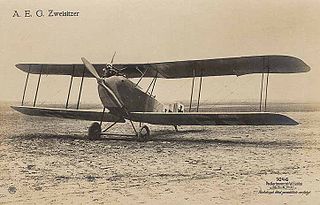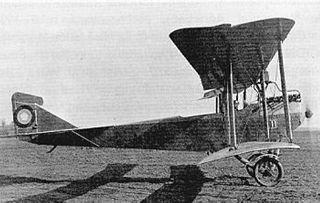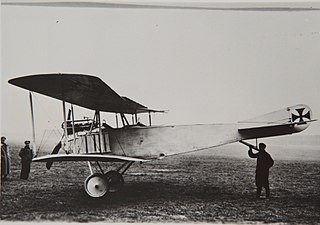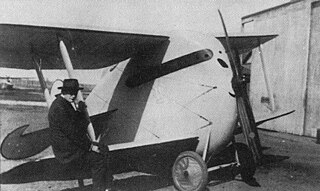| B.I and B.II | |
|---|---|
 | |
| DFW B.I Tannenberg, one of the few "named" DFW aircraft | |
| Role | Reconnaissance / Army co-operation |
| Manufacturer | Deutsche Flugzeugwerke |
| Designer | Walter Oelerich |
| Introduction | 1914 |
| Retired | 1915 |
| Primary user | Luftstreitkräfte |

The DFW B.I (factory designation MD 14), was one of the earliest German aircraft to see service during World War I, and one of the numerous "B-class" unarmed, two-seat observation biplanes of the German military in 1914, but with a distinctive appearance that differentiated it from contemporaries. [1] Though a biplane, its crescent-planform three-bay wings were inspired by that of the earlier Rumpler Taube monoplane, and led to the DFW aircraft being named the Fliegende Banane ("Flying Banana") by its pilots.

The German Empire, also known as Imperial Germany, was the German nation state that existed from the unification of Germany in 1871 until the abdication of Kaiser Wilhelm II in 1918.

World War I, also known as the First World War or the Great War, was a global war originating in Europe that lasted from 28 July 1914 to 11 November 1918. Contemporaneously described as "the war to end all wars", it led to the mobilisation of more than 70 million military personnel, including 60 million Europeans, making it one of the largest wars in history. It is also one of the deadliest conflicts in history, with an estimated nine million combatants and seven million civilian deaths as a direct result of the war, while resulting genocides and the 1918 influenza pandemic caused another 50 to 100 million deaths worldwide.

A biplane is a fixed-wing aircraft with two main wings stacked one above the other. The first powered, controlled aeroplane to fly, the Wright Flyer, used a biplane wing arrangement, as did many aircraft in the early years of aviation. While a biplane wing structure has a structural advantage over a monoplane, it produces more drag than a similar unbraced or cantilever monoplane wing. Improved structural techniques, better materials and the quest for greater speed made the biplane configuration obsolete for most purposes by the late 1930s.
Contents
The B.II was similar but was built as a trainer. Some were fitted with the more powerful Mercedes D.II engine.

A trainer is a class of aircraft designed specifically to facilitate flight training of pilots and aircrews. The use of a dedicated trainer aircraft with additional safety features—such as tandem flight controls, forgiving flight characteristics and a simplified cockpit arrangement—allows pilots-in-training to safely advance their real-time piloting, navigation and warfighting skills without the danger of overextending their abilities alone in a fully featured aircraft.

The Mercedes D.II was a six-cylinder, SOHC valvetrain liquid-cooled inline aircraft engine built by Daimler during the early stages of World War I. Producing about 110 to 120 hp, it was at the low-end of the power range of contemporary engines, and was generally outperformed by rotaries whose power-to-weight ratio tended to be much better. It also had stiff competition from the Ferdinand Porsche-designed 120 hp Austro-Daimler 6. The D.II was produced only briefly as a result, but its design formed the basis for the later Mercedes D.III which saw widespread use throughout the war.
















